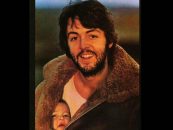The Inspiration For Deep Purple’s ‘Smoke on the Water’
by Best Classic Bands StaffEvery rock fan knows Deep Purple’s “Smoke on the Water.” For one thing, it has one of the most memorable signature opening riffs—four notes, in G minor, played on a Fender Stratocaster by Ritchie Blackmore—that any band has ever devised. You can’t not break into an embarrassingly manic air guitar pose as soon as you hear it!
But it’s the backstory that makes “Smoke on the Water” even more intriguing. Presumably, most who heard it around the time it was released—first on Deep Purple’s 1972 Machine Head album and then as a single, which reached #4 in Billboard the following year—were familiar with the true tale it told; it was big news at the time. But younger listeners, who may have gravitated toward the tune while learning to play guitar—or just heard it on classic rock radio—might not have a clue what Ian Gillan was singing about.
Here’s the story behind “Smoke on the Water.” On December 4, 1971, Deep Purple was in Montreux, Switzerland, planning to cut an album using a mobile recording studio rented from the Rolling Stones (“the Rolling truck Stones thing” of the lyrics) at an entertainment complex on the Lake Geneva shoreline that included the Montreux Casino and a theater. Frank Zappa and the Mothers of Invention were booked to play that theater and the idea was that, after they vacated the premises—which were about to close down for the winter after their gig—Deep Purple would make their recording.
It didn’t work out that way. During the Zappa concert, as keyboardist Don Preston began a synthesizer solo, “some stupid with a flare gun burned the place to the ground.” The fire spread rapidly, taking out the casino, the band’s equipment and anything else it could claim. Fortunately there were no deaths and only relatively minor injuries, thanks in part to the song’s “funky Claude”—Montreux Jazz Festival impresario Claude Nobs—who directed some concertgoers trapped by the flames out of the complex.

The ruins of the Montreux casino complex in 1971. The fire was the inspiration for Deep Purple’s “Smoke on the Water”
Howard Kaylan, formerly the lead singer of the Turtles, was a member of the Mothers at the time. In his memoir, Shell Shocked, he recalled the incident:
“Our show was at 2:30 in the afternoon, which was already a bit unusual. We were appropriately casual and had a really good set. It was during one of our final encores, ‘King Kong,’ [that] ‘Some hippie with a flare gun burned the place to the ground.’ He really did. A joker in the back of the crowd wanted to show his appreciation for the show with a bang and a flare sent straight up and into the bamboo ceiling, which ignited like tinder…The audience panicked. Zappa did the responsible thing and quietly advised the crowd to remain calm. Then he threw his guitar on the ground and ran to get the hell out of there. The kids were now throwing our amplifiers out of the windows behind the stage in order to jump the two stories to the ground below. There were pushing and shoving bodies everywhere and, as you can imagine, a great many injuries. We escaped by running through the kitchen and then, down the side stairway in just the nick of time. The entire building burned to ashes. Fortunately, nobody died. We were taken, by bus, back to our hotel across the lake, and stood there, looking out of the scenic lobby at the Alpine view of a column of flame and smoke reaching to the sky. The whole band was there together. We sipped brandy and watched our equipment vaporize.”
Watch an interview with Frank Zappa following the Montreux incident
Deep Purple’s plan to record at the site was, naturally, scuttled. The band scrambled to relocate and first attempted to record at a local theater (where they laid down a basic track for the song that would become “Smoke on the Water”), before moving on to the Montreux Grand Hotel, where they finished most of the album that would become Machine Head, their first top 10 album. It was at the hotel that the vocal for “Smoke on the Water”—its title provided by bassist Roger Glover, the lyrics by Gillan and, of course, the guitar parts by Blackmore (keyboardist Jon Lord and drummer Ian Paice rounded out the band)—was finished up.
The song was released on May 21, 1973, debuting on the Record World singles chart at #93 on May 26. It became, along with 1968’s “Hush,” Deep Purple’s biggest U.S. hit at #4 (on Billboard‘s Hot 100, though it reached #2 on Record World on Aug. 4).
Related: Our Album Rewind of Machine Head
Today, it’s considered one of rock’s all-time greatest songs, and that guitar riff nearly always places close to the top when such lists are tabulated. In Montreux, Switzerland, a sculpture commemorating the incident and the song it bred stands proudly, and inside of the casino that currently thrives in Montreux, the four notes instantly recognizable as the lead-in to “Smoke on the Water” are displayed on a balcony.
Watch Deep Purple perform “Smoke on the Water” in the early ’70s
Tickets to see Deep Purple in concert are available here and here.
Related: Deep Purple performed the song at their 2016 Rock Hall induction







1 Comment so far
Jump into a conversationSee the DVD of “The Making of Machine Head”……I think Eagle Rock put it out. Tells the story of this, and more.